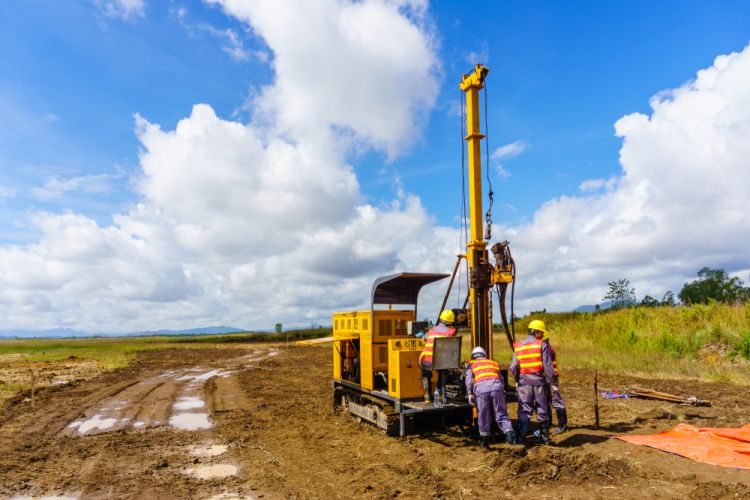Excitement About Specialized Geotechnical Engineering Solutions
See This Report on Specialized Geotechnical Engineering Solutions
Table of ContentsSome Known Factual Statements About Specialized Geotechnical Engineering Solutions Getting The Specialized Geotechnical Engineering Solutions To WorkMore About Specialized Geotechnical Engineering SolutionsThe Best Strategy To Use For Specialized Geotechnical Engineering Solutions
They conduct website examinations, gather samples, carry out lab tests, and examine data to assess the suitability of the ground for building and construction jobs. Based upon their findings, geotechnical designers provide suggestions for foundation design, incline security, preserving structures, and reduction of geotechnical hazards. They work together with other experts, such as designers, architectural engineers, and construction teams, to guarantee that geotechnical factors to consider are incorporated right into the total task layout and execution.
Foundation Layout: Geotechnical designers play a crucial role in creating structures that can safely sustain the designated structure. They examine the soil problems and lots needs to figure out the proper structure kind, such as superficial foundations (e.g., grounds), deep structures (e.g., stacks), or specialized strategies like dirt renovation. They take into consideration variables such as settlement limitations, bearing ability, and soil-structure interaction to establish optimum foundation styles.
What Does Specialized Geotechnical Engineering Solutions Do?
Right here are some sorts of geotechnical designers: Foundation Engineer: Foundation designers concentrate on designing and analyzing foundations for structures - Specialized Geotechnical Engineering Solutions. They evaluate the soil conditions, lots requirements, and site attributes to determine one of the most proper foundation kind and style, such as superficial foundations, deep foundations, or specialized strategies like stack structures
They execute area testing, gather samples, and analyze the accumulated data to identify the dirt buildings, geologic developments, and groundwater problems at a site. Geotechnical Instrumentation Designer: Geotechnical instrumentation engineers concentrate on monitoring and measuring the actions of soil, rock, and frameworks. They mount and preserve instrumentation systems that keep track of elements such as dirt settlement, groundwater levels, slope activities, and architectural variations to analyze performance and offer very early warnings of prospective concerns.
In the workplace atmosphere, geotechnical engineers make use of specialized software program devices to perform estimations, produce designs, and analyze information. Specialized Geotechnical Engineering Solutions. They prepare records, evaluation project specifications, interact with clients and employee, and coordinate task tasks. The workplace setting gives a conducive setting for study, analysis, and cooperation with various other professionals associated with the project
They regularly check out job websites to carry out website examinations, assess geotechnical problems, and gather information for analysis. These visits involve traveling to different areas, often in remote or difficult surfaces. Geotechnical engineers might carry out soil tasting, conduct examinations, and display building activities to make sure that the geotechnical elements of the task are being applied properly.
A Biased View of Specialized Geotechnical Engineering Solutions
Geotechnical designers additionally function in specialized geotechnical reference labs. In these facilities, they perform experiments, execute examinations on soil and rock samples, and analyze the design homes of the materials. Geotechnical research laboratory designers work extensively in these settings, managing testing equipment, running instruments, and tape-recording information. They work together with other research laboratory personnel to ensure exact and trusted testing outcomes.
Preserving Walls: Developing walls that keep back soil to avoid landslides and supply security on sloped terrains. Embankments and Earthworks: Designing embankments for roadways, trains, and dams to ensure they remain secure under tension. The mining sector relies greatly on geotechnical engineering to make sure the safety and durability of its procedures.
With this in mind, we have developed our program to prepare trainees for success. Geotechnical engineers are involved in all stages of the layout of structures, from principle to construction. Their work is essential in the style and planning process as they evaluate the integrity of soil, clay, silt, sand, and rock, prior to construction starting.
The smart Trick of Specialized Geotechnical Engineering Solutions That Nobody is Talking About
This is followed by a ground examination based on the searchings for of the workdesk research study and entails trial matching and tasting to discover any kind of potential problems. Geotechnical designers work within multidisciplinary groups, sustained by intermediate and junior engineers as well as by CAD professionals. As a senior geotechnical designer on a hydro plant task, tasks might consist of taking part in technological evaluations (e.g., peer reviews), tailings clog inspections, dam safety and security evaluations, and other research studies associated with the style and construction of mine waste centers.
While some professionals are experts exclusively in geotechnics, others might function under titles like engineering geologist or ground engineer within similar abilities. As a geotechnical designer, you'll need to: build read this and preserve connections with customers and various other specialists associated with the site, throughout each projectmaintain security requirements on website be conscious of cost implications when you make recommendationsstudy geological maps and aerial photographs from a variety of sources and from different time periodsexamine building intends to see just how viable you can find out more they are based upon your understanding of the siteinvestigate threats or geological hazards for the sitesearch for environmentally sensitive features, such as landfill start to develop factual and interpretive ground modelsplan field investigationsdrill and analyse samples of bedrock, soil, groundwater and additional materials monitor other professionals on sitesolve technological concerns as they emerge, such as unexpected structures at drill sitesmonitor problems throughout and after building and construction to see to it structures are secure in the brief and lengthy termadd information gathered on site to your initial researchcreate geotechnical computations, illustrations, and 2 or three-dimensional computer designs interpreting the datamake recommendations about the proposed usage of the website.
There are great deals of possibilities to satisfy new people, as you'll collaborate with a variety of experts at every site. The work can be difficult as you may be liable for the safety and security of others while on site. There is also a high degree of monetary responsibility, as the referrals you make can have major cost effects.
